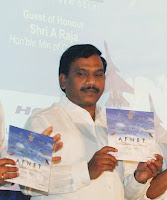Inflation in India is not coming down despite all brain-scratching and actions by India's topmost official economists and the Reserve Bank of India. All their projections on inflation have fallen flat, and this is happening for the last two years. They keep guessing if a good monsoon would bring it down, or a tight monetary policy would. Government's efforts to reduce fiscal deficit have failed due to their and state governments' profligacy. Even if they have been able to contain fisc to some extent, it is not showing up in inflation figures. A general thinking that rationalises high inflation is that the above 8% growth is leading to inflation. Inshallah, if we believe in such trade off between inflation and growth, the growth will soon go down below 8%.
No doubt, inflation/ price rise is a complex problem, linked to a hundred things many of which are not in government control and many have origin outside India. But rationalising inflation would not do. We must find an answer. It appears that the government and its economists are going by the rule book, and this precisely could be the main reason for the problem. In complex economic situations, you need to find new solutions. For that you need to think out of box.
I am not suggesting that I have the solution. But let me give one example of what the governmental economists might be missing when they are looking for [obvious] solutions. Has someone in the government thought of the population is humans? Have they applied what is called behavioural economics also to see why inflation is on the rise? Has some economist analysed how the consumerist society is pushing up demand of items that do not generate wealth in real sense? Has somebody tried to link the circulation of huge unaccounted money with inflation?
Will somebody give the government the correct diagnosis and the government administer the right medicine? If not, the economists will do the accounting based on the books they have read, and will keep telling you why they could not control inflation/ price rise [and other ills of Indian economy].
No doubt, inflation/ price rise is a complex problem, linked to a hundred things many of which are not in government control and many have origin outside India. But rationalising inflation would not do. We must find an answer. It appears that the government and its economists are going by the rule book, and this precisely could be the main reason for the problem. In complex economic situations, you need to find new solutions. For that you need to think out of box.
I am not suggesting that I have the solution. But let me give one example of what the governmental economists might be missing when they are looking for [obvious] solutions. Has someone in the government thought of the population is humans? Have they applied what is called behavioural economics also to see why inflation is on the rise? Has some economist analysed how the consumerist society is pushing up demand of items that do not generate wealth in real sense? Has somebody tried to link the circulation of huge unaccounted money with inflation?
Will somebody give the government the correct diagnosis and the government administer the right medicine? If not, the economists will do the accounting based on the books they have read, and will keep telling you why they could not control inflation/ price rise [and other ills of Indian economy].





